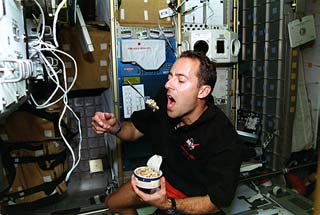


Shuttle life is fairly comfortable. The crew wears ordinary clothing. They move about, work, and relax, unencumbered by bulky space suits. The orbiter's air is about 79 percent nitrogen and 21 percent oxygen. It is cleaner than Earth's air, and pollen-free, at a pressure equal to Earth's at sea level, 14.7 pounds per square foot. Carbon dioxide and other impurities are removed by filters. Excess moisture is also removed, keeping the humidity comfortable. The temperature is kept between 61 and 90 degrees Fahrenheit.
Meals can be eaten anywhere in the crew areas, although astronauts normally like to dine "family style," in the middeck area. A galley oven provides heating for some foods. Hot and cold water are available. One crewmember can ready meals for four people in about 5 minutes. Special trays separate the different foods and keep them from floating off. Despite microgravity, most foods "stick" to ordinary spoons and forks. Food trays attach to a crew member's legs or to orbiter surfaces, with adhesive straps.
Before flights, crewmembers choose between more than 70 foods and 20 beverages. A typical day's meals include: breakfast of orange drink, peaches, scrambled eggs, sausage, cocoa, and a sweet roll; lunch of cream of mushroom soup, ham and cheese sandwich, stewed tomatoes, banana, and cookies; and dinner of shrimp cocktail, beefsteak, broccoli au gratin, strawberries, pudding, and cocoa. Menus provide about 2,700 calories daily, because astronauts need as many calories in space as they do on Earth.
The shuttle does not have a refrigerator. Most foods are dehydrated, to save weight and storage. Water for rehydration is a byproduct of the fuel cells, which generate electricity. Some foods are thermostabilized -- heat-sterilized, then sealed in cans or plastic pouches. Some foods, such as cookies and nuts, are available, ready-to-eat.
Sanitation is crucial in the confines of the shuttle. Some microbes can multiply quickly in a confined microgravity environment and potentially could infect everyone onboard. As a result, all living areas are regularly cleaned. Eating utensils are cleaned with wet wipes containing a strong disinfectant. Crewmembers' pants are changed weekly; socks, shirts, and underwear are changed every 2 days; and all used clothing is sealed in airtight plastic bags after being worn. Garbage and trash are also sealed in plastic bags and brought back to Earth.
Shuttle crewmembers take "sponge baths." An airflow system directs any loose waste water into the orbiter's waste collection system, where it is sealed in plastic watertight bags. For shaving, crew members use shaving cream and wipe their face with a towel, or use a wind-up shaver with a vacuum that sucks up cut whiskers. Crewmembers use a toilet much like one on an airliner. In place of gravity, air flow directs waste to the bottom of the toilet, where it goes directly into a sealed container to be processed and stored.
Sleep and recreation are important to good health in space. Crewmembers can sleep in "free float," or they use special berths with good air circulation to eliminate "pockets" of carbon dioxide buildup. Crewmembers follow scientifically planned exercise programs to counter microgravity's effects on the heart, veins, and muscles. For recreation, games, books, writing material, and tape recorders are available. Microgravity offers many ways to have fun.
Related Links:
Long-Duration Spaceflight
Life on Mir
Life in Microgravity
Space Shuttle Orbiter
![]()
|
|
Curator:
Kim Dismukes
Responsible NASA Official: John Ira Petty |
.gif)